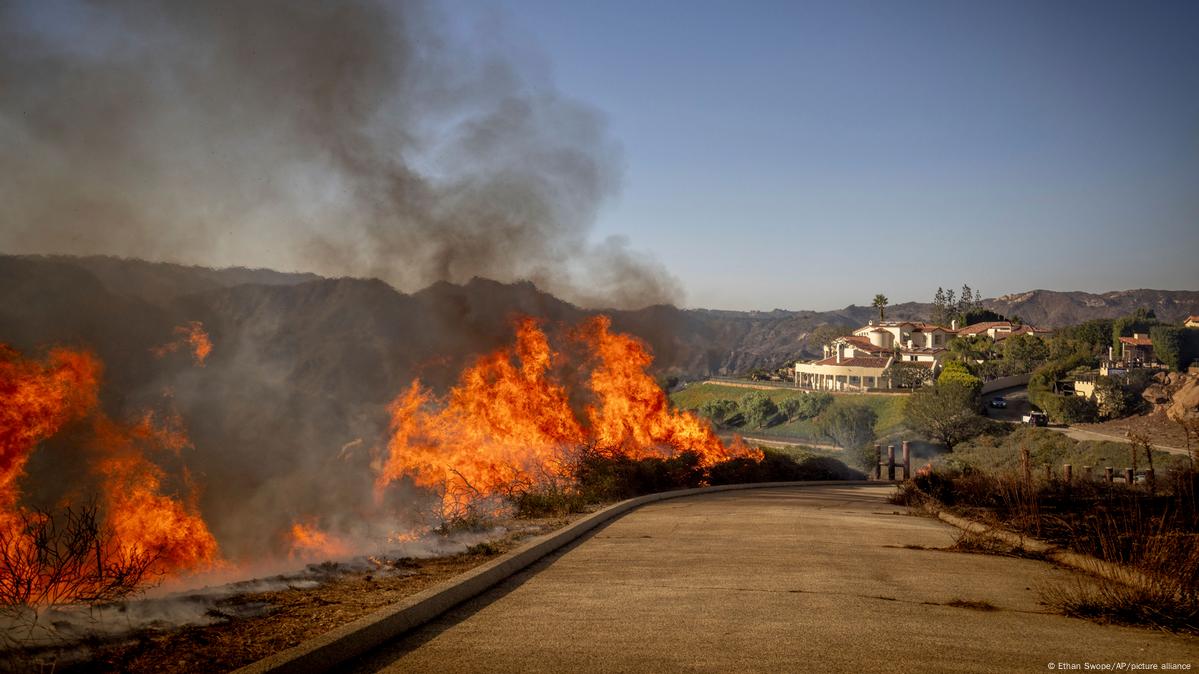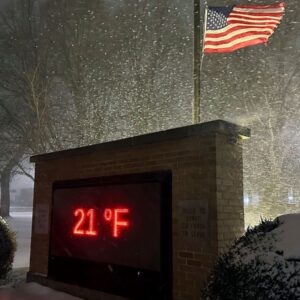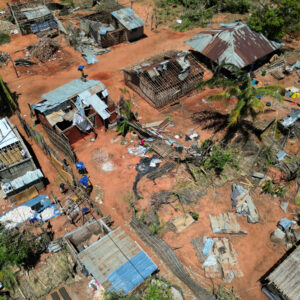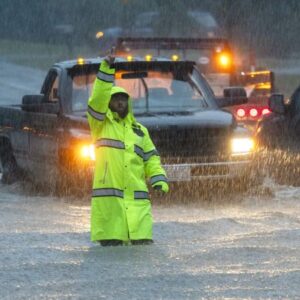Wind-fueled L.A Wildfires force thousands to Flee from Nature’s Fury is an in-depth exploration of the escalating environmental crisis in Los Angeles, California. The piece focuses on the devastating wildfires, fueled by strong winds, that have forced thousands of residents to evacuate their homes and flee from the wrath of nature. The narrative not only highlights the immediate danger and destruction caused by these fires, but also delves into the broader implications of such disasters on the environment, economy, and the lives of the affected people. This is the first part of a series that examines the increasing frequency and intensity of natural disasters, and their compounding effects.
“Compounding Disasters: Wind-Fueled L.A Wildfires Force Thousands to Flee from Nature’s Fury”
 The phenomenon of compounding disasters is not a new one, but it has been gaining increased attention in recent years due to the escalating severity and frequency of such events. One such instance is the wind-fueled wildfires that have been ravaging Los Angeles, forcing thousands of residents to flee from nature’s fury. This article aims to provide an understanding of how these compounding disasters occur, using the L.A wildfires as a case study.
The phenomenon of compounding disasters is not a new one, but it has been gaining increased attention in recent years due to the escalating severity and frequency of such events. One such instance is the wind-fueled wildfires that have been ravaging Los Angeles, forcing thousands of residents to flee from nature’s fury. This article aims to provide an understanding of how these compounding disasters occur, using the L.A wildfires as a case study.
Wildfires are a natural part of many ecosystems, playing a crucial role in maintaining biodiversity and promoting growth. However, when they occur in populated areas, they can cause extensive damage to property and pose a significant threat to human life. The situation becomes even more dire when these fires are fueled by strong winds, as has been the case in Los Angeles.
The wildfires in Los Angeles are a prime example of a compounding disaster. The city, known for its dry, hot climate, is naturally prone to wildfires. However, the situation has been exacerbated by the Santa Ana winds, which are strong, extremely dry down-slope winds that originate inland and affect coastal Southern California and northern Baja California. These winds have the effect of fanning the flames, causing the fires to spread rapidly and unpredictably.
The Santa Ana winds are a natural phenomenon, occurring regularly in the fall and winter months. However, climate change has been linked to an increase in their frequency and intensity. This, coupled with the ongoing drought in California, has created the perfect conditions for wildfires to thrive.
 The impact of these compounding disasters is devastating. Thousands of residents have been forced to evacuate their homes, with many losing everything they own. The fires have also caused widespread damage to infrastructure, including power lines and roads, further complicating evacuation efforts and making it difficult for emergency services to reach those in need.
The impact of these compounding disasters is devastating. Thousands of residents have been forced to evacuate their homes, with many losing everything they own. The fires have also caused widespread damage to infrastructure, including power lines and roads, further complicating evacuation efforts and making it difficult for emergency services to reach those in need.
The economic cost of these disasters is also significant. The insurance industry has been hit hard, with claims for fire damage reaching record levels. The tourism industry, a major source of income for the region, has also been affected, with many visitors choosing to stay away due to the perceived risk.
The L.A wildfires highlight the need for a better understanding of compounding disasters and how they can be managed. It is clear that traditional approaches to disaster management, which often focus on a single hazard, are not sufficient in the face of these complex, interconnected events. A more holistic approach is needed, one that takes into account the interplay between different hazards and the underlying vulnerabilities that make communities susceptible to these disasters.
The wind-fueled wildfires in Los Angeles are a stark reminder of the power of nature and the devastating impact of compounding disasters. They underscore the urgent need for more research into these events and the development of effective strategies to mitigate their effects. As climate change continues to alter our environment, it is likely that we will see more of these compounding disasters in the future, making it imperative that we are prepared to face them.
Escaping the Inferno and Preparing for Tomorrow

The L.A wildfires were fueled by strong winds. The impact was severe, forcing thousands of people to flee from their homes due to the intensity of nature’s fury. The Compounding Disasters Part 1: Wind-fueled L.A Wildfires highlights the escalating threat of natural disasters, particularly wildfires, exacerbated by climate change. The wind-fueled wildfires in Los Angeles have resulted in mass evacuations, demonstrating the significant impact of such disasters on human lives, property, and the environment. The situation underscores the urgent need for effective disaster management strategies and climate change mitigation efforts.
The wind-driven L.A. wildfires are a stark reminder of nature’s unpredictable and destructive power. As thousands race to escape the inferno, the resilience and solidarity of affected communities shine through the chaos. These fires are not just a call to action for immediate safety but also a plea for long-term solutions to mitigate future disasters.
Preparing for tomorrow means addressing climate change, improving wildfire prevention strategies, and fostering stronger emergency response systems. While the flames may eventually subside, the lessons from this crisis must endure. Together, through preparedness and resolve, we can face nature’s wrath and build a safer, more resilient future.







купить аккаунт купить аккаунт
площадка для продажи аккаунтов платформа для покупки аккаунтов
магазин аккаунтов социальных сетей https://magazin-akkauntov-online.ru/
продажа аккаунтов соцсетей безопасная сделка аккаунтов
продать аккаунт магазин аккаунтов социальных сетей
продажа аккаунтов kupit-akkaunt-top.ru/
купить аккаунт платформа для покупки аккаунтов
Account Market Account Store
Accounts market accountsmarketplacepro.com
Secure Account Purchasing Platform Website for Selling Accounts
Buy accounts Sell Pre-made Account
Verified Accounts for Sale Online Account Store
Sell accounts Buy and Sell Accounts
Sell accounts Marketplace for Ready-Made Accounts
Website for Selling Accounts Account Selling Service
Sell Account Social media account marketplace
Accounts market Account market
account buying platform buy accounts
guaranteed accounts sell account
accounts marketplace account exchange service
buy accounts website for buying accounts
buy accounts account catalog
verified accounts for sale account purchase
buy accounts account trading service
online account store account marketplace
account selling platform secure account sales
account selling platform accounts for sale
buy pre-made account marketplace for ready-made accounts
find accounts for sale verified accounts for sale
account exchange buy and sell accounts
account sale https://accounts-for-sale.org/
gaming account marketplace account market
verified accounts for sale accounts for sale
account acquisition account selling service
account selling platform https://best-social-accounts.org
sell pre-made account account trading
guaranteed accounts account marketplace
website for buying accounts account market
account selling platform account market
account buying platform account market
account marketplace https://discount-accounts.org
database of accounts for sale gaming account marketplace
account acquisition top-social-accounts.org
purchase ready-made accounts https://shop-social-accounts.org
sell pre-made account https://accounts-offer.org/
social media account marketplace https://accounts-marketplace.xyz
marketplace for ready-made accounts https://social-accounts-marketplaces.live/
ready-made accounts for sale https://accounts-marketplace.live
account exchange service https://social-accounts-marketplace.xyz/
account exchange service https://buy-accounts.space
buy pre-made account https://buy-accounts-shop.pro
sell account https://buy-accounts.live/
gaming account marketplace accounts-marketplace.online
accounts for sale https://social-accounts-marketplace.live/
account buying service https://accounts-marketplace-best.pro
маркетплейс аккаунтов соцсетей https://akkaunty-na-prodazhu.pro
площадка для продажи аккаунтов rynok-akkauntov.top
маркетплейс аккаунтов соцсетей https://kupit-akkaunt.xyz
продать аккаунт akkaunt-magazin.online
магазин аккаунтов https://akkaunty-market.live/
маркетплейс аккаунтов https://kupit-akkaunty-market.xyz
продажа аккаунтов https://akkaunty-optom.live
биржа аккаунтов online-akkaunty-magazin.xyz
маркетплейс аккаунтов https://akkaunty-dlya-prodazhi.pro/
маркетплейс аккаунтов https://kupit-akkaunt.online/
buy facebook accounts for ads https://buy-adsaccounts.work
facebook ad accounts for sale https://buy-ad-accounts.click
facebook ad accounts for sale buy aged facebook ads account
buy facebook ad account https://buy-ads-account.click
buy facebook account facebook ad account buy
facebook ads account for sale https://buy-ads-account.work
buy fb ads account https://ad-account-for-sale.top
В этой публикации мы сосредоточимся на интересных аспектах одной из самых актуальных тем современности. Совмещая факты и мнения экспертов, мы создадим полное представление о предмете, которое будет полезно как новичкам, так и тем, кто глубоко изучает вопрос.
Изучить вопрос глубже – https://medalkoblog.ru/
buy facebook ads manager buying facebook accounts
adwords account for sale https://buy-ads-account.top
google ads agency account buy buy google ads
buy fb ad account buy fb account
adwords account for sale https://ads-account-for-sale.top
buy google ads account https://ads-account-buy.work
google ads account for sale https://buy-ads-invoice-account.top
google ads agency accounts https://buy-account-ads.work
google ads account seller https://buy-ads-agency-account.top/
buy aged google ads accounts buy google adwords accounts
google ads agency account buy https://ads-agency-account-buy.click
buy facebook bm buy fb bm
google ads account buy https://buy-verified-ads-account.work/
buy verified business manager buy facebook business managers
facebook business manager account buy https://buy-verified-business-manager-account.org
unlimited bm facebook https://buy-verified-business-manager.org/
facebook business account for sale https://buy-business-manager-acc.org/
buy business manager https://business-manager-for-sale.org
buy facebook business manager verified https://buy-business-manager-verified.org/
buy verified facebook https://buy-bm.org/
buy facebook verified business manager https://buy-business-manager-accounts.org
buy tiktok ads account https://buy-tiktok-ads-account.org
unlimited bm facebook verified-business-manager-for-sale.org
tiktok ads account for sale https://tiktok-ads-account-buy.org
tiktok ads account for sale https://tiktok-ads-account-for-sale.org
tiktok ads account for sale https://tiktok-agency-account-for-sale.org
buy tiktok ads https://buy-tiktok-ad-account.org
tiktok ad accounts https://buy-tiktok-ads-accounts.org
buy tiktok ads accounts buy tiktok ads accounts
buy tiktok ads account https://buy-tiktok-business-account.org
buy tiktok business account https://buy-tiktok-ads.org
Your point of view caught my eye and was very interesting. Thanks. I have a question for you.
9q1fg2